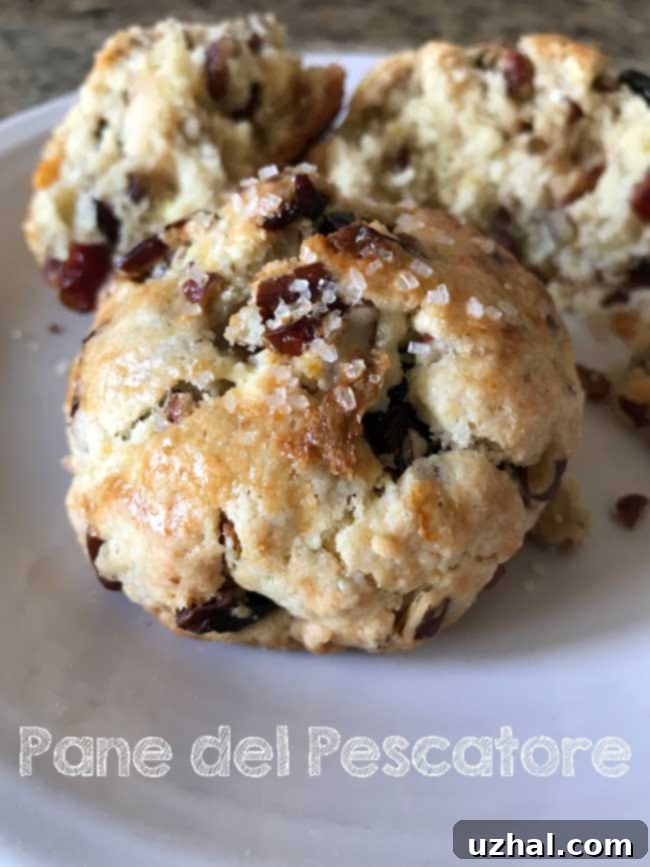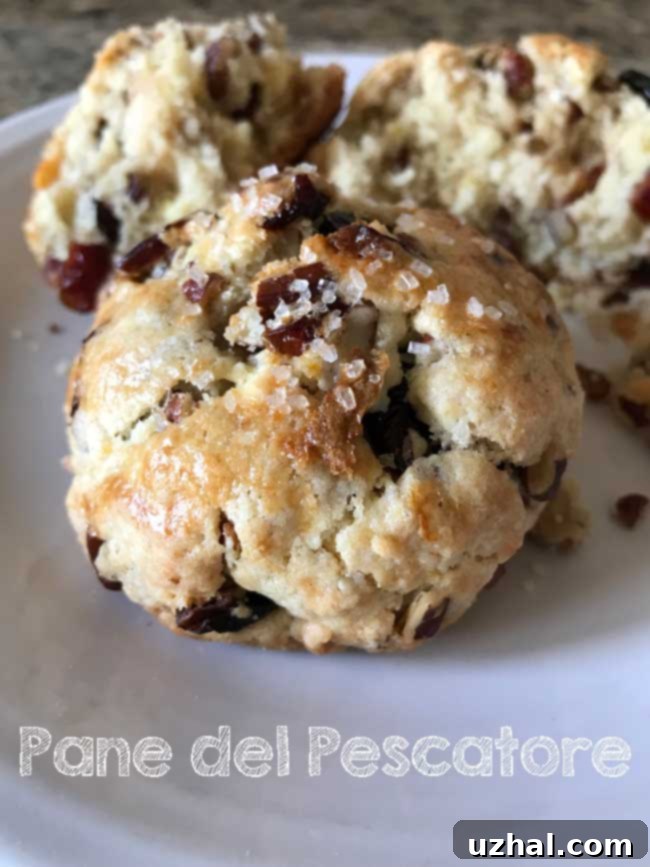Authentic Pane del Pescatore: A Delectable Fishermen’s Bread Cookie Recipe from Tuscany
Embark on a delightful culinary journey to the heart of Tuscany with our exquisite recipe for Pane del Pescatore, affectionately known as Fishermen’s Bread. This traditional Italian cookie, a cherished discovery from a memorable trip to Florence several years ago, offers a truly unique texture and flavor profile. Imagine a round cookie with a distinctively hard, subtly crunchy shell that gives way to a wonderfully soft, moist, and crumbly interior. This inviting core is generously studded with a vibrant medley of dried fruits and toasted nuts, creating a bite that is both comforting and sophisticated. Pane del Pescatore stands as a testament to the simple yet profound flavors of Italian baking, a must-try for any cookie enthusiast.

While the size of Pane del Pescatore might initially remind you of classic scones or American biscuits, their texture and character are entirely their own. The exterior provides a satisfying dryness and a delicate crunch, creating a beautiful contrast with the rich, tender crumb within. This interior is a treasure trove of balanced flavors, brimming with the natural sweetness of dried fruit and the earthy warmth of toasted nuts. What truly sets these Italian cookies apart is how their taste and texture gracefully evolve over time. Many enthusiasts, including myself, find that they develop an even deeper, more complex flavor and a pleasantly firmer interior after a day or two. This transformation only adds to their charm, making them a perfect make-ahead treat that seemingly improves with age and offers a different, yet equally enjoyable, experience.

The Growing Appeal of Less Sweet Italian Cookies
In a culinary landscape often dominated by overly sweet desserts, Pane del Pescatore offers a refreshing and welcome alternative. There are dozens of traditional ways to make these Tuscan cookies, yet they sometimes remain a lesser-known gem among home bakers. Lately, I’ve found myself increasingly drawn to treats that offer a more nuanced and understated sweetness, allowing the inherent flavors of the ingredients to truly shine. These Italian cookies perfectly align with that preference; their inherent balance ensures that the natural goodness of the fruit, nuts, and delicate citrus zest takes center stage, rather than being overshadowed by excessive sugar.
This desire for less overtly sweet indulgences has spurred a delightful period of experimentation in my kitchen. I’ve been exploring various flavor combinations and even varying flour types to achieve the ideal harmony of sweetness and texture in these unique cookies. Embracing the “less sweet” philosophy doesn’t mean sacrificing flavor; it actually means elevating the quality and interplay of each individual ingredient. With Pane del Pescatore, the intention is not merely a sugary kick, but a complex and harmonious blend of textures and aromas that satisfies without overwhelming the palate. The dried fruits contribute concentrated bursts of natural sweetness, while the nuts add an earthy depth and a satisfying crunch. The subtle notes of orange and lemon zest, often overlooked, provide a bright, aromatic lift that beautifully complements the richness of the dough, making these cookies incredibly versatile and enjoyable for any time of day.

Choosing the Right Flour for Your Fishermen’s Bread: Type 00 vs. Bread Flour
The foundation of any exceptional cookie, especially traditional Italian ones, lies significantly in its flour, and for Pane del Pescatore, the choice can profoundly impact the final texture. Traditionally, many authentic Italian baked goods, including these delightful Tuscan cookies, benefit immensely from Type 00 flour. This remarkably finely milled Italian flour, produced from soft winter wheat, is celebrated for its lower protein content and incredibly silken texture. These characteristics contribute to a delicate, tender crumb and a superior bite, making it a staple in professional Italian bakeries. Thankfully, in many parts of the world, including bustling cities like Chicago, gourmet ingredients such as Type 00 flour are becoming increasingly accessible to home bakers.
However, if Type 00 flour proves difficult to source or you prefer to use what’s readily available, do not let that deter you from preparing these delicious Fishermen’s Bread cookies. Standard bread flour serves as an excellent and highly effective substitute. While bread flour inherently possesses a higher protein content, which typically results in a chewier texture in many baked goods, when expertly combined with the other carefully measured ingredients in this particular recipe, it still yields a wonderfully satisfying result. The key insight here is to understand that slight variations in flour type will naturally lead to subtle differences in the final texture of your cookies, but all paths lead to a genuinely delicious and enjoyable outcome. For passionate home bakers, the ability to adapt and utilize readily available pantry staples is an invaluable asset, and this versatile recipe graciously allows for that very flexibility without compromising on flavor or quality.
Tailoring Texture: The Art of Adjusting Eggs and Baking Time for Your Ideal Cookie
Beyond the choice of flour, several other crucial elements provide ample opportunity to fine-tune the texture of your Pane del Pescatore to your exact preference. The quantity of egg incorporated into your dough, for instance, plays a remarkably pivotal role in determining the final crumb structure. A slightly higher egg content tends to produce a more cake-like, noticeably softer, and richer interior, making the cookies feel more tender and moist. Conversely, carefully reducing the egg amount slightly will naturally result in a drier, firmer, and more robust crumb, appealing significantly to those who prefer a less moist or more substantial cookie. Experimenting with these precise gram amounts can truly personalize your baking experience, allowing you to create the exact cookie texture you crave.
Furthermore, baking time and oven temperature offer significant control over achieving your desired final texture. For a softer, more wonderfully crumbly inside with a satisfyingly firm yet not overly hard exterior, adhering to the recommended baking time at a moderate temperature of 375 degrees F (190 degrees C) is absolutely ideal. However, if your preference leans towards an even drier, almost biscotti-like crunch, particularly for the interior of your Pane del Pescatore, you can achieve this by extending the baking time at a lower heat. This deliberate and slow drying process within the oven gradually transforms the crumb, intensifying the complex flavors of the dried fruits and nuts and creating a delightful snap. It’s truly all about personal preference, and this particular recipe is wonderfully forgiving and adaptable, genuinely inviting you to explore and discover your own perfect version of Pane del Pescatore.
Endless Flavor Combinations: Customizing Your Pane del Pescatore with Creativity
One of the most exciting and rewarding aspects of baking Fishermen’s Bread is the boundless potential for flavor customization. The classic combination of sweet golden raisins and earthy almonds is undeniably delicious, offering a timeless pairing of sweetness and nutty crunch that is always a crowd-pleaser. However, this recipe actively encourages and embraces improvisation, effectively transforming it into a versatile canvas for your unique culinary creativity. Consider exploring a vibrant and contrasting mix of tart dried cranberries and creamy white chocolate chips, beautifully complemented by the rich, buttery notes of toasted pecans. Alternatively, you might venture into more exotic territories with finely chopped dried figs, bright green pistachios, and a subtle hint of aromatic cardamom for a truly unique taste experience.
The inherent beauty of this particular recipe truly lies in its remarkable adaptability. Each small batch of dough comes together incredibly quickly, often requiring only a few minutes of active preparation, which conveniently allows you to whip up multiple different flavor combinations without investing a significant amount of effort. You can effortlessly divide the prepared dough into smaller portions and infuse each with its own unique selection of fillings. For example, shape one portion with the traditional golden raisins and almonds, then move on to another with a modern twist of dried cherries and decadent dark chocolate. This flexibility makes it absolutely perfect for catering to diverse tastes, accommodating dietary preferences, or simply exploring new favorites and expanding your baking repertoire. Do not be afraid to utilize what you already have on hand – leftover holiday fruit mix, various nuts from your pantry, or even different types of citrus zests can all find a wonderful and harmonious home in these incredibly versatile Italian cookies. The sheer joy of baking these cookies is genuinely found in the exciting discovery and creation of your own signature flavor blend, making each batch a personal masterpiece.
- Pane del Pescatore (Original Recipe)
- More Pane del Pescatore Inspiration
- Italian Rock Cookies (Similar Texture)
- Inside Out Carrot Cake Cookies
- Inside Out Brownie Cookies
Recipe: How to Make Pane del Pescatore (Fishermen’s Bread)

Fishermen’s Bread aka Pane del Pescatore
Cookie Madness
Pin Recipe
Ingredients
- 1 cup plus 2 T. sifted or weighed bread or type 00 flour (approx. 150 grams for accurate measurement and best texture)
- ¼ teaspoon salt plus a pinch (enhances all flavors)
- ¼ teaspoon baking powder (for a light, tender crumb)
- ¼ cup plus 1 tablespoon sugar (approx. 60 grams, for balanced sweetness)
- ¼ teaspoon each – fresh orange and lemon zest (or just lemon zest for a purer citrus note, provides aromatic brightness)
- 3 ½ tablespoons softened unsalted butter (approx. 50 grams, at room temperature for easy blending and tender texture)
- 1 large egg (approx. 55 grams, essential for binding and moisture, brought to room temperature)
- ½ teaspoon pure vanilla extract (or a delightful blend of half vanilla and half Fiori di Sicilia for an authentic Italian essence)
- ⅓ cup toasted chopped pecans (or toasted almonds, walnuts, or hazelnuts – use more if you desire an even nuttier bite)
- ⅓ cup golden raisins or dried cherries (or any dried fruit you adore, such as dried cranberries, finely chopped apricots, or figs for varied texture and flavor)
- A little extra beaten whole egg for brushing (for a beautiful golden crust and sheen)
- Optional Extras: A handful of white chips or chopped white chocolate, additional chopped toasted almonds, mini chocolate chips (milk or dark), pistachios, currants, or other favorite inclusions to personalize your cookies.
Instructions
-
Step 1: Prepare Your Workspace. Begin by preheating your oven to a precise 375 degrees F (190 degrees C). It’s crucial for consistent baking results. While the oven heats, carefully line a sturdy, large cookie sheet with high-quality parchment paper. This simple step prevents the cookies from sticking and ensures a more even bake, making cleanup significantly easier.
-
Step 2: Combine Dry Ingredients. In the spacious bowl of a stand mixer, fitted with the paddle attachment, meticulously combine all the dry ingredients: the measured flour (whether it’s Type 00 or bread flour), salt, baking powder, sugar, and both the orange and lemon zests. Mix thoroughly on a low speed until all these dry components are uniformly blended and integrated. This crucial step ensures that the leavening agent and the aromatic citrus flavors are evenly distributed throughout your Pane del Pescatore dough, contributing to consistent taste and texture.
-
Step 3: Incorporate Wet Ingredients and Flavorings. Now, add the softened unsalted butter, the room temperature large egg, and your chosen vanilla extract (or the delightful Fiori di Sicilia blend) to the meticulously blended dry mixture in the mixer bowl. With the mixer still running on a low speed, stir everything together until the ingredients are just combined and a cohesive dough begins to form. Make sure to frequently stop the mixer and scrape down the sides and bottom of the bowl with a rubber spatula. This prevents any dry pockets and ensures all ingredients are fully incorporated. Once the dough is mostly formed, gently fold in your toasted chopped nuts and dried fruit of choice. For optimal results and even distribution of these delicious inclusions, briefly knead the dough by hand directly in the bowl for approximately 30 seconds to one minute. This gentle kneading helps to evenly spread the fruits and nuts without overworking the dough, which could otherwise lead to tough cookies.
-
Step 4: Shape and Prepare for Baking. Carefully divide the prepared dough mixture into 5 equal portions. Take each portion and gently roll it into a smooth, uniformly round ball. Arrange these perfectly shaped balls onto your parchment-lined baking sheet, ensuring they are spaced approximately 3 inches apart. This generous spacing is essential to allow for adequate spreading during the baking process and to prevent them from merging. For a beautiful, glossy golden finish and a slightly crispier crust, lightly brush the tops of each cookie with a little extra beaten whole egg. If desired, you can also sprinkle additional chopped almonds or other preferred nuts over the brushed surface for an enhanced visual appeal and an extra textural boost, making your Fishermen’s Bread even more enticing.
-
Step 5: Bake to Perfection. Carefully place the baking sheet into your preheated 375-degree F (190 degrees C) oven. Bake the cookies for approximately 25 minutes. This specific timing should yield the classic Pane del Pescatore with deliciously dark, beautifully golden, and slightly crisp edges, while maintaining a wonderfully soft, moist, and delightfully crumbly interior. If you prefer a distinctively crunchier Italian cookie throughout, aiming for a more biscotti-like texture, you can adjust the baking process: bake for an initial 20 minutes at 375 degrees F (190 degrees C), then reduce the oven temperature significantly to 250 degrees F (120 degrees C) and continue baking for an additional 20 minutes. This two-stage baking method helps to dry out the interior more thoroughly, achieving that desired crunch. Once baked to your preference, remove the cookies from the oven and allow them to cool completely on the baking sheet. Cooling is an essential step for the cookie’s structure and final texture to set properly, ensuring they are perfect for enjoyment.
Serving Suggestions and Storage Tips for Pane del Pescatore
Once your freshly baked Pane del Pescatore cookies have cooled completely, they are perfectly ready to be savored and enjoyed! These remarkably versatile Italian treats pair wonderfully with a steaming cup of your favorite coffee, making them an ideal and comforting breakfast accompaniment. Alternatively, they are delightful alongside a warm mug of tea, transforming them into a delightful and satisfying afternoon snack. For those seeking a more sophisticated culinary experience, consider serving these robust cookies alongside a sweet dessert wine or a classic glass of Vin Santo, which is a traditional Tuscan pairing. Their rich and nuanced flavor profile also makes them a fantastic and visually appealing addition to any festive cookie platter or holiday spread, sure to impress your guests.
To ensure your Fishermen’s Bread remains at its peak freshness and flavor, it’s best to store them in an airtight container at room temperature. When stored correctly, they will maintain their exceptional quality for up to a week, allowing you to enjoy them over several days. As previously mentioned, many enthusiasts find that their flavor and texture actually improve after a day or two, as the interior has more time to firm up slightly and the various flavors meld and deepen harmoniously. For significantly longer storage, these delightful cookies freeze beautifully for up to 2-3 months. Simply wrap each cookie tightly in plastic wrap to prevent freezer burn, then place them in a freezer-safe bag or an airtight container. When you’re ready to enjoy them again, simply thaw them at room temperature, and they’ll taste just as fresh and delicious as the day they were originally baked.
Why You’ll Fall in Love with Baking These Tuscan Cookies
Baking Pane del Pescatore is much more than simply following a set of instructions; it is a true invitation to experience a cherished piece of Tuscan culinary tradition right within the warmth and comfort of your own kitchen. Their truly distinctive contrast between a wonderfully crisp outer shell and a soft, moist, and generously fruit-and-nut-filled interior makes them unequivocally stand out from typical cookies. The incredible ability to effortlessly customize the fillings and meticulously fine-tune the texture ensures that each and every batch you bake can be a unique, personal reflection of your individual taste and creative spirit. Whether you are a seasoned and experienced baker with years of practice or just embarking on your baking journey, the inherent simplicity and wonderfully forgiving nature of this particular recipe make it both accessible and profoundly rewarding. So, gather your carefully chosen ingredients, enthusiastically embrace the authentic spirit of Italian improvisation, and prepare to delight all your senses with these truly special Fishermen’s Bread cookies. They are not merely a delightful treat; they are a genuine celebration of simple, wholesome flavors that promise to bring immense joy with every single, delectable bite.
